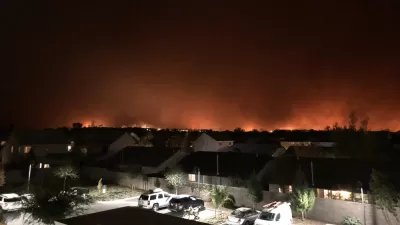InTransition magazine examined the daunting difficulties transportation authorities and the public faced while trying to evacuate Tokyo on the day of the Great Tohuku Earthquake in March.
The article reports that despite a "synchronous failure" of the region's transportation network, infrastructure and technologies, people overall managed to keep calm and get home safely.
"It was 2:46 p.m. on a Friday, three hours before most of Tokyo's huge population of office workers would head home. The transit system was busy with typical off-peak riders, such as shoppers, tourists and children returning from school. With the confirmed detection of a major earthquake (the exact magnitude was, at first, underestimated), all of the major trains were shut down on the spot by operators whether they had power or not. ..."
"[O]f all places, Tokyo, with its huge LED displays and bright-as-daylight-even-at-night intersections, has so often served as the ultimate showplace: Here is how the future will look and how it will work. But the earthquake kicked it over as easily as Godzilla wreaked havoc on cardboard and plaster versions of Tokyo in one of the old movies. Those modern pieces of infrastructure-all hooked together like nerves and circuits to make the city actually run-failed. Sometimes they failed singly, sometimes in groups, but altogether they left a very large metro- politan area minus much of its vital infrastructure, including, of course, the rail systems that weave Tokyo and the larger Kanto area together. ..."
Thanks to Karl Vilacoba
FULL STORY: How a Shaken City Kept Steady Nerves

Maui's Vacation Rental Debate Turns Ugly
Verbal attacks, misinformation campaigns and fistfights plague a high-stakes debate to convert thousands of vacation rentals into long-term housing.

Planetizen Federal Action Tracker
A weekly monitor of how Trump’s orders and actions are impacting planners and planning in America.

San Francisco Suspends Traffic Calming Amidst Record Deaths
Citing “a challenging fiscal landscape,” the city will cease the program on the heels of 42 traffic deaths, including 24 pedestrians.

Defunct Pittsburgh Power Plant to Become Residential Tower
A decommissioned steam heat plant will be redeveloped into almost 100 affordable housing units.

Trump Prompts Restructuring of Transportation Research Board in “Unprecedented Overreach”
The TRB has eliminated more than half of its committees including those focused on climate, equity, and cities.

Amtrak Rolls Out New Orleans to Alabama “Mardi Gras” Train
The new service will operate morning and evening departures between Mobile and New Orleans.
Urban Design for Planners 1: Software Tools
This six-course series explores essential urban design concepts using open source software and equips planners with the tools they need to participate fully in the urban design process.
Planning for Universal Design
Learn the tools for implementing Universal Design in planning regulations.
Heyer Gruel & Associates PA
JM Goldson LLC
Custer County Colorado
City of Camden Redevelopment Agency
City of Astoria
Transportation Research & Education Center (TREC) at Portland State University
Jefferson Parish Government
Camden Redevelopment Agency
City of Claremont





























